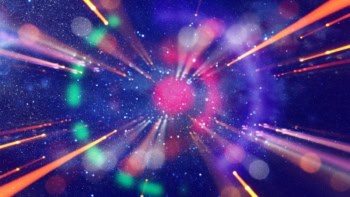The international CDF collaboration at Fermilab has made the most precise measurement to date of the extremely rapid transitions between matter and antimatter. The experiment has found that certain B mesons spontaneously turn into their own antiparticle equivalents -- anti-B mesons -- and back again at a rate of three trillion times per second. The result agrees well with the Standard Model of particle physics and confirms yet again the existence of CP violation -- the reason why there is more matter than antimatter in the universe.
Cosmologists believe that equal amounts of matter and antimatter were created in the big bang. But if matter and antimatter particles were exact opposites of each other, they should have annihilated to leave only photons. This did not happen, which is why there is so much more matter than antimatter in the universe.
The existence of our matter-dominated universe suggests that matter and antimatter underwent different processes after the big bang. In the Standard Model of particle physics, a process called charge-parity (CP) violation is responsible for the difference between matter and antimatter. CP violation means that the laws of physics change slightly when a particle is replaced by its antiparticle and when all three directions in space are reversed.
CP violation can manifest itself in different ways. In the “indirect” process, first observed in neutral kaon particles in 1964, quantum mechanics allows particles to change into their antiparticles and back again in a process known as “mixing”. In 2001, The BaBar team, working at the Stanford Linear Accelerator (SLAC) — and independently the Belle collaboration at the KEK laboratory in Japan — were the first experiments to detect this in a B meson. BaBar observed “direct” CP violation in 2004 by showing that the number of decays observed for B mesons was higher than for their antiparticle equivalents.
A B meson is a short-lived particle made up of both matter and antimatter — one quark and one antiquark. The CDF physicists measured the rate of matter-antimatter transitions for the neutral Bs meson, a particle composed of a “bottom” quark and a “strange” antiquark. They did this at the Tevatron proton-antiproton collider at Fermilab by analysing data from over a billion collisions in an experiment called “Tevatron Run II”, which began in 2001. Although the Tevatron produces many orders of magnitude more hadrons than do the machines at KEK and SLAC, it is nevertheless much harder to study the decay of B mesons in proton-antiproton collisions.
The experiment found that the transition rate is three trillion (3 x 1012) times per second, measured to a precision of 2%. This is the most precise measurement of this rate ever made and agrees very well with predictions in the Standard Model. A separate analysis by the D0 collaboration at Fermilab was only able to give a range for the transition rate of between 2.7 and 3.3 trillion times per second.
The new result also places stringent constraints on other more exotic models, such as supersymmetry theories, that require oscillation rates that are much higher still. In other words, establishing the oscillation frequency makes it possible to begin to study CP violation in Bs mesons, which could in turn lead to signs of physics outside the Standard Model.
“Although the new measurement confirms the Standard Model with precision, it cannot — by itself — fully explain the observed imbalance between matter and antimatter in the universe,” says CDF team member Aurore Savoy-Navarro of the University of Paris VI in France. “In this sense, the result adds to this mystery!”



